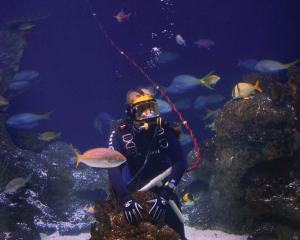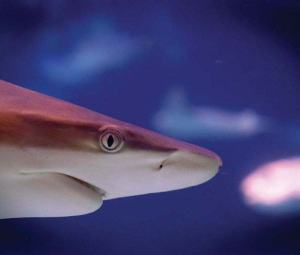
This article originally appeared in the May/June 2017 issue of Museum magazine.
How one museum used a community engagement business model to drive programming and growth.
Magnetic: The Art and Science of Engagement, a best-selling book published by the AAM Press in 2013, profiles six museums that strengthened their programs, finances, brands, and audiences by engaging internal and external communities. “Magnetism” is the ability to attract and grow four essential types of capital: core (i.e., program, facilities, human), financial brand, and social.
One captivating story of programmatic reinvention. business transformation. and sustained growth features the Greensboro Science Center in North Carolina (formerly the Natural Science Center of Greensboro, as it was referenced in Magnetic). The Greensboro Science Center (GSC) has consistently demonstrated leadership and resolve for change while its home city has moved more slowly and carefully toward post-recession rejuvenation. This alone is a measure of GSC’s success-that it has thrived despite the city’s fiscal caution. Between 2010 and 2016 the science center opened seven new exhibits and programs, and annual visitation increased 45 percent, from 291,000 to 430,530. The operating budget has grown eightfold, from $32 million to $5.8 million. and full-time staff has more than doubled, from 20 to 45 employees.
Magnetic authors Anne Bergeron and Beth Tuttle recently sat down with GSC’s leadership team-Glenn Dobrogosz, president and CEO; Rick Betton. chief operating officer; and Beth Hemphill chief financial officer, to understand what has fueled their ongoing progress.
What were the conditions that enabled GSC’s transformation?
In 1999, civic leaders created Action Greensboro, a consortium of nonprofits, foundations, and business leaders dedicated to rebuilding the economic vitality of the city. Greensboro was hungry for dynamic projects to increase its confidence and pave the way for growth. We were a beloved museum [founded in 1957] that had been static for years and were ready for a change. Greensboro also had business and educational interests that were directly linked to our potential for success-issues relating to quality of life, economic impact through cultural tourism, science education, and conservation. The rebounding economic and cultural conditions in Greensboro were a perfect match for Glenn, the director who arrived in 2004. We had a dedicated staff and board ready to create impact and a new leader with no prior connection to Greensboro, unfettered by the past and eager to construct a new vision for the institution and with the city.
All successful business models are built on an underlying vision and value proposition that are compelling enough to engender sustained financial support. What has made GSC so attractive to its constituents?
Over the past decade, we have evolved from a sleepy, unaccredited municipal zoo to an independent, dynamic, and fully accredited all-in-one zoo, science museum, and aquarium. We focus on what can set us apart in terms of showcasing the diversity of life and science-a conservation center for endangered species, for example-as well being innovative and risk-taking. These aren’t just buzzwords for us but true imperatives. We also ensure that everything we do fulfills our four primary goals:
- to make Greensboro a better and more attractive place to live, raise a family, and build a business
- to inspire all age groups. through science education and technology, to think more deeply about and engage with the limitless worlds of life and science
- to create economic impact, plus build self-respect for and awareness of our city
- to establish meaningful partnerships in research and conservation that impact the field

We have worked hard to create a true public-private partnership with our community that is mutually reinforcing. The city invests in us and we serve its needs. and vice versa; we have become an inseparable part of the community’s identity and a source of real pride. We were able to do this because just before Glenn arrived in 2004, the GSC reorganized from a city-funded agency to an independent nonprofit. This set us up to be a nimble organization that could move dynamically and take risks. Our abiding commitment to the city has fueled our growth as an economic engine and tourism driver.
GSC was a small organization without a lot of financial momentum in 2005 when this transformation was first envisioned. How did you change your business model?
We began by talking to the community. Then we created a master plan for phased growth over a 10-plus-year period that was mission-oriented and responsive to the marketplace. We defined our metrics of success relating to our four goals, and we allowed ourselves to be fluid and flexible in implementing the plan while remaining true to its original premise. Our approach has been to innovate and test while building our brand. We also sought to broaden our customer base beyond the local community, to the region, then the state. And now we’re working to be recognized both on a national and international level for our education and conservation work.
Our first step was to revitalize the zoo into an animal discovery center, which provides a more intimate human-animal educational experience. This doubled our attendance. We capitalized on the public’s growing interest by securing a $20 million bond to build North Carolina’s first inland aquarium. From there, we launched our first capital campaign. That leveraged $10 million from the private sector to complete our next phase of growth, which enabled us to reinvent our museum and expand the zoo.
What did you learn in your first period of growth and change (2005-2013) that has supported and accelerated GSC’s continued evolution (2013-present)?
We learned that our unique three-in-one destination model has resonated with our community’s leaders and citizens by providing a signature asset for Greensboro. The concept of economic development through science-based tourism is making its way into the mainstream consciousness of a city that had not previously focused on the potentials of tourism. Greensboro has increasingly embraced science-based tourism every year, and this will be a huge plus moving forward. What will propel us through our next phase of growth is continuing to push forward with a commitment to offering diverse experiences for a range of audiences.
Taking risks creates reward. especially when a leadership team is surrounded by dedicated, driven, and impassioned colleagues, as well as board members who are inspired by change. At GSC, our stakeholders now expect frequent change instead of fearing it. As a science center and museum, we have learned to rely on our timeless icons, dinosaurs, animals, space, the human body, biology, chemistry, and physics, as long as we find new and inventive
ways to rethink and remake how we use them to inspire new generations.

before cleaning the corals of algae.
Diver teaches visitors daily about ocean conservation and species adaptations before cleaning the corals of algae.
One of the most important lessons is that comfort and complacency go hand in hand; and it’s a good idea to always reject both!
How were new fundraising approaches and earned revenue strategies a factor in GSC’s growth equation?
The bulk of our livelihood comes in the form of earned income, including paid admissions, shop and cafe sales, and incremental revenues for special experiences like the OmniSphere [surround-sound and 3-D projection theater] or Penguin Encounter. We have focused attention on providing increased online opportunities for visitors to scan the range of experiences we offer; then plan and purchase their itineraries in advance. This has created an easier, more seamless experience for our guests that begins well before they arrive at the gate.
We used to expend a lot of energy on too many fundraising events throughout the~ and now have focused and streamlined those to five signature events that support our conservation activities and operations. We analyzed the true cost of these events and their return on investment and used that data to decide which to continue. A result of this analysis is that the events have gotten stronger, are better attended. and are more profitable.
The Association of Zoos and Aquariums (AZA) advocates for individual zoos to allocate a certain percentage of their annual budgets to wildlife preservation and conservation. and GSC has adopted this concept. We not only have prioritized this as a goal but are engaging our visitors in helping us decide where to direct funds. Each paying guest receives a token worth 25 cents to direct toward one of a handful of conservation and research projects that GSC supports worldwide. Currently, we have projects focusing on sharks and oceans, Komodo dragon conservation. and Venus flytrap habitats.
Tell us more about leveraging private support. How did you go from annually raising only $220,000 of contributed revenue In 2010 to $3 million In 2016?
We embraced philanthropy in ways we never had before. Initially, many of the staff were wary of donors having too much influence. But that perception has shifted through an internal education process. In late 2013, we hired our first director of development, who helped us set boundaries and draw the line that we’re not willing to cross. Some of the staff who were originally the most hesitant are now fundraising champions.
After an external feasibility study indicated we could raise $6 million, we launched our Think Big campaign in 2015. We’ve already raised $8.7 million and anticipate closing the public phase of the campaign at $10 million; and we did this in Greensboro, where there is a great deal of competition for limited philanthropic funds. We achieved this by being intentional and remaining true to our moral compass. Plus, we were accustomed to doing things on a shoestring budget, and we’re still cautious with money. Donors trust that we will use their gifts wisely, and in turn, staff members demonstrate their appreciation for the support.

What role does data play at GSC in terms of decision-making, ongoing planning, and business modeling?
We began this journey without data; we proceeded just on instinct and a lot of big ideas. Once we rallied people behind our new vision, we then built the capacity to do things like modeling and scenario planning. Today, GSC has become an excellent data-driven business thanks to new people coming on board and talented longtime team members developing new skills. We always knew our gut instincts would need to be backed up by data-audience and financial metrics, and a real understanding of the ways expanded attendance and more program offerings can diversify and increase revenue. We subscribe to a never-ending drive toward research to identify and understand cutting-edge opportunities in our profession.
To get here, we needed to be more transparent and build financial literacy throughout the staff and board Our trustees now want more metric analysis to show at a glance where we are and where we are going. GSC’s department heads know which performance indicators matter, such as general admission trends, and those are things we monitor constantly. We developed a report called the “Cork Board” to capture, visualize, and convey data, which we distribute monthly.
Our active participation in AAM, AZA, and the Association of Science-Technology Centers has provided invaluable learning and professional development opportunities. In the last three years, seven staff members have become AZA inspectors, which is the best learning opportunity team members could have.
Organizations don’t change unless the people within them change. That happens in one of two ways: either new people join the team or existing people develop new skills and embrace a mental shift. How did this play out at GSC among your staff and board?
The existing GSC team was exceptional, and we just needed to add some new people. We have worked hard to create a culture that is open and transparent. Everyone keeps the mission and vision in mind, even when they come from different perspectives.
We’ve also evolved from an organization that was a few strong minds taking some gutsy moves to a team that is phenomenal and able to imagine and take those risks more broadly. Our internal mantra is “Dream, Design. Build” We’ve been fortunate to attract some new talent with different expertise and have given them the freedom and room to grow. We also hire wisely, assessing not just what someone can do. but who they are as a person and how they will fit within the GSC culture.
We’ve experienced enormous change on the board, evolving away from general management to immersive leadership around our core values. We now actively seek three categories of trustees: doers, connectors, and donors. And we have a formal governance committee and nominating process, which has moved beyond tapping buddies to assessing candidates’ willingness to work, raise money, and actively serve on committees. We also have an energetic Finance Committee that aids the management team in vetting new projects and ensuring that our financial approaches are strategic and sound.
You mentioned the importance of culture. How would you characterize GSC’s culture?
Trust, innovation, impact, passion, and boldness are five words that come immediately to mind. Everything we’ve done was made possible by first creating an environment of trust among our staff, leadership team, and board. This has allowed us to feel safe enough to take calculated risks to leap forward, knowing that we might sometimes fall short.
We have also committed ourselves to seeking innovation at every turn and in every decision. The COO has been known to say, “‘Around here, if it ain’t broke, we just might fix it anyway!” and that has been a major factor in our success. We don’t rest on our laurels. Our audience is always asking us, “What’s next?” And we ask ourselves, “What can we do better or differently that will add real value to our visitors and to our region as a tourism destination?”
Our staff focus every day on creating and sharing positive stories of people making a difference through science and in the lives of animals. Over the last several years, this has meant that both internal and external stakeholders can see the impact they have and the meaning they play a part in making. This sense of impact stokes the passion that each of us feel for the work we do together. It means that our team is inspired to work hard, be inventive, do a lot with few resources, and have fun while doing it.
Lastly; our staff and board embrace the challenge of change boldly and without fear. We regularly set off into uncharted waters with the recognition that opportunity is awaiting discovery. Such is the beauty of science!
In 2013, when Magnetic was published, you were just about to open the SciQuarium, which telegraphed your transition from a zoo to a zoo-science museum-aquarium. Tell us about the evolution of GSC’s programs and offerings.
The SciQuarium, now called the Wiseman Aquarium, opened in 2013, and the following year we had record high attendance of more than 430,000 guests. During that year, we also opened a new ticketing area and lobby, expanded our gift shop, and enhanced the OmniSphere experience. We added a cafe, which donates all of its profit to GSC.
In 2015, we opened “Skywild,” a treetop adventure course [that mimics animals’ behavior in their habitats, comprising seven courses and zip lines more than 45 feet high] to attract the teen to 30-something demographic. This year, we will open several new attractions and animal encounter experiences, including a 5,000-square-foot expansion of the Wiseman Aquarium featuring 17 new exhibits, plus giant touch-wall technology.
Describe to us how GSC has continued to be “magnetic” since it was profiled in the book.
Prior to 2013, we were experimenting with projects and ideas, and taking risks that we thought could or should captivate and magnetize audiences. We were molding a broad vision into something more specific and quantifiable. Since 2013, we have more confidence that we have earned some degree of credibility as innovators, calculated risk takers, and out-of-the-box thinkers. However, this newly found confidence must be exercised carefully. It must be managed without ego and always be community-centric. It requires increased financial acuity and the ability to understand our demographic boundaries within the boundary-less world of science. Most importantly, it always needs to be focused on science inspiration and literacy. And somehow, we need to maintain the exhaustive process of continually predicting what people will want and need five to ten years in the future.
Have we become more “magnetic”? Our team has learned so much, and we are better professionals today than we were during our earlier “learning years.” We are better at developing programs, operating facilities, raising funds, managing finances, and using social media to increase awareness. Our brand is about unpredictability, change, and never being just one thing. Our brand is being “unbranded:’ It is like we’ve made it through a Marine basic training obstacle course. Now we’re ready to take those new skills and increased muscle mass to begin a new phase of maturation while retaining the dreams and aspirations of youth.
The top two zoos in the country are in Omaha and Columbus, which are not the top two markets in the country. But visionary leaders in partnership with visionary communities looked ahead, thought big, and convinced others to join in the dream. That’s what we hope to do here in Greensboro.
We’re on track to complete our master plan by 2020. We’ve been able to make steady progress because we have been clear about our goals from the beginning, and we ensure that everything we do fulfills those goals.
An adapted excerpt from Magnetic: The Art and Science of Engagement (2013, the AAM Press) can be found in the online Building Cultural Audiences Lab: http://labs.aam-us.org/buildingculturalaudiences/magnetic-the-art-and-science-of-engagement/.
Magnetic: The Art and Science of Engagement can be purchased from the AAM Bookstore through our partners at Rowman & Littlefield: https://rowman.com/ISBN/9781933253831/Magnetic-The-Art-and-Science-of-Engagement.
A four-part webinar series on Magnetic Museums can be found in the AAM Recorded Webinar Library at: aam-us.org/resources/online-programs/mission-and-institutional-planning-webinars.
Anne Bergeron is managing director of the Brown Arts Initiative at Brown University. Beth Tuttle is president and CEO of DataArts (formerly known as the Cultural Data Project).







